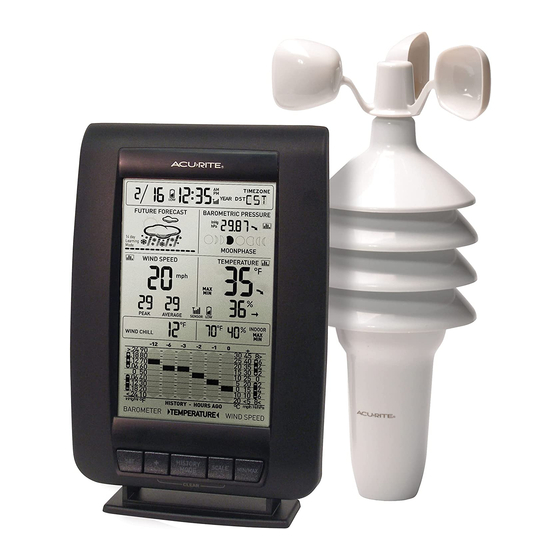ACU-RITE 00634 사용 설명서 - 페이지 2
{카테고리_이름} ACU-RITE 00634에 대한 사용 설명서을 온라인으로 검색하거나 PDF를 다운로드하세요. ACU-RITE 00634 7 페이지.

SEC TION 1 • OVERVIEW OF FEATURES
MAIN UNIT
ATOMIC CLOCK:
Automatically maintains
accuracy and resets for
daylight saving time
FUTURE FORECAST:
Self calibrating
weather forecast
WIND SPEED:
Current wind speed,
Peak wind speed,
Average wind speed
SEASONAL
INFORMATION:
Heat Index,
Dew Point,
Wind Chill
(automatic)
HISTORY GRAPH:
last 12 hours of
Barometer,
Outdoor Temperature,
Wind Speed
(user selectable)
WIRELESS SENSOR
ANEMOMETER:
Provides wind speed,
wind speed peak and
wind speed average
SOLAR-WEATHER SHIELD:
Provides some protection
from solar radiation
affecting temperature
readings and prevents
precipitation from entering
into the instrumentation pod.
SURFACE MOUNT BRACKET
ATOMIC CLOCK:
Atomic clock signal
reception indicator
BAROMETRIC PRESSURE:
Current value with trend
indicator
Moonphase
OUTDOOR CONDITIONS:
Temperature & Humidity
with Trend Indicators
WIRELESS SENSOR:
Low Battery indicator
INDOOR CONDITIONS:
Temperature & Humidity
WIRELESS SENSOR:
Wireless reception indicator
Setup and Operation
Buttons
Tabletop Placement
Display Stand
BATTERY COMPARTMENT
INSTRUMENTATION POD:
Houses the sensitive
instrumentation and the
wireless 433 MHz transmitter
that provides weather
information to the main
display unit.
MOUNTING POINT:
The wireless sensor can be
mounted onto a pipe
(pipe not included) or
onto the included surface
mount bracket
- 2 -
About the Atomic Clock
A clock is considered atomic if it has an accuracy of one second in a million years.
Consumer clocks are considered atomic if they attain this accuracy by receiving a
signal from an atomic clock. In North America, the National Institute of Standards and
Technologies operates an atomic clock in Colorado which transmits the time codes
via the radio station WWVB. The Acurite clock you have purchased includes a built-in
receiver which picks up the signal from the WWVB station. For the best possible
reception, place the main unit with the back side facing Colorado. NOTE: Due to solar
radiation in the atmosphere, the atomic clock signal is weaker during the day. Most
synchronization with the WWVB atomic clock signal happens at night when there is
less interference.
About the Wireless Sensor
This wireless weather station features a wireless sensor that provides wind,
temperature and humidity data and broadcasts this information to the main display
unit. This wireless sensor will provide accurate outdoor weather conditions when
placed properly. The wireless sensor contains sensitive electronic components and a
balanced anemometer (for wind speed measurement). Care must be taken during
setup and when considering placement to make certain the unit is not dropped or
struck with any falling debris from trees or structures.
SEC TION 2 • SETUP
A/B/C Wireless Selection
To allow for more than one weather station and wireless sensor network to be
used in close proximity, the main unit and the wireless sensor have a small
switch labeled "A B C" within the battery compartments. This switch selects one
of 3 wireless modes to use, and both switches MUST be set in matching
positions (either A, B, or C) for wireless communication to take place
successfully.
Battery Choice & Temperature Range
Extended periods of cold temperatures ( below -4ºF / -20ºC ) can cause alkaline
batteries to function improperly. This will cause the outdoor wireless sensor to stop
transmitting temperature readings. Use lithium batteries in these low temperature
conditions to ensure continued operation for wireless sensors placed outdoors. NOTE:
Rechargeable batteries are not recommended due to higher operating voltages.
40
- 3 -
